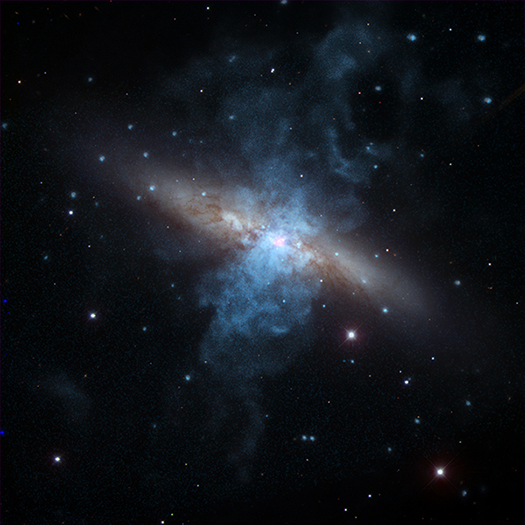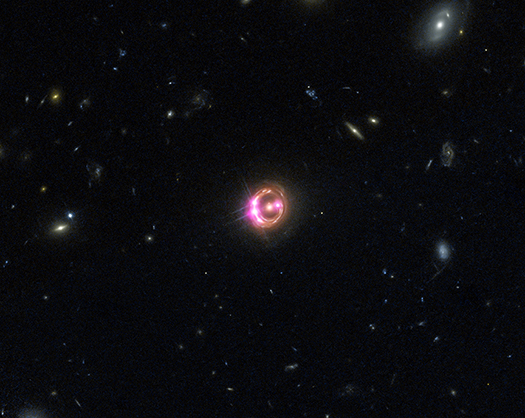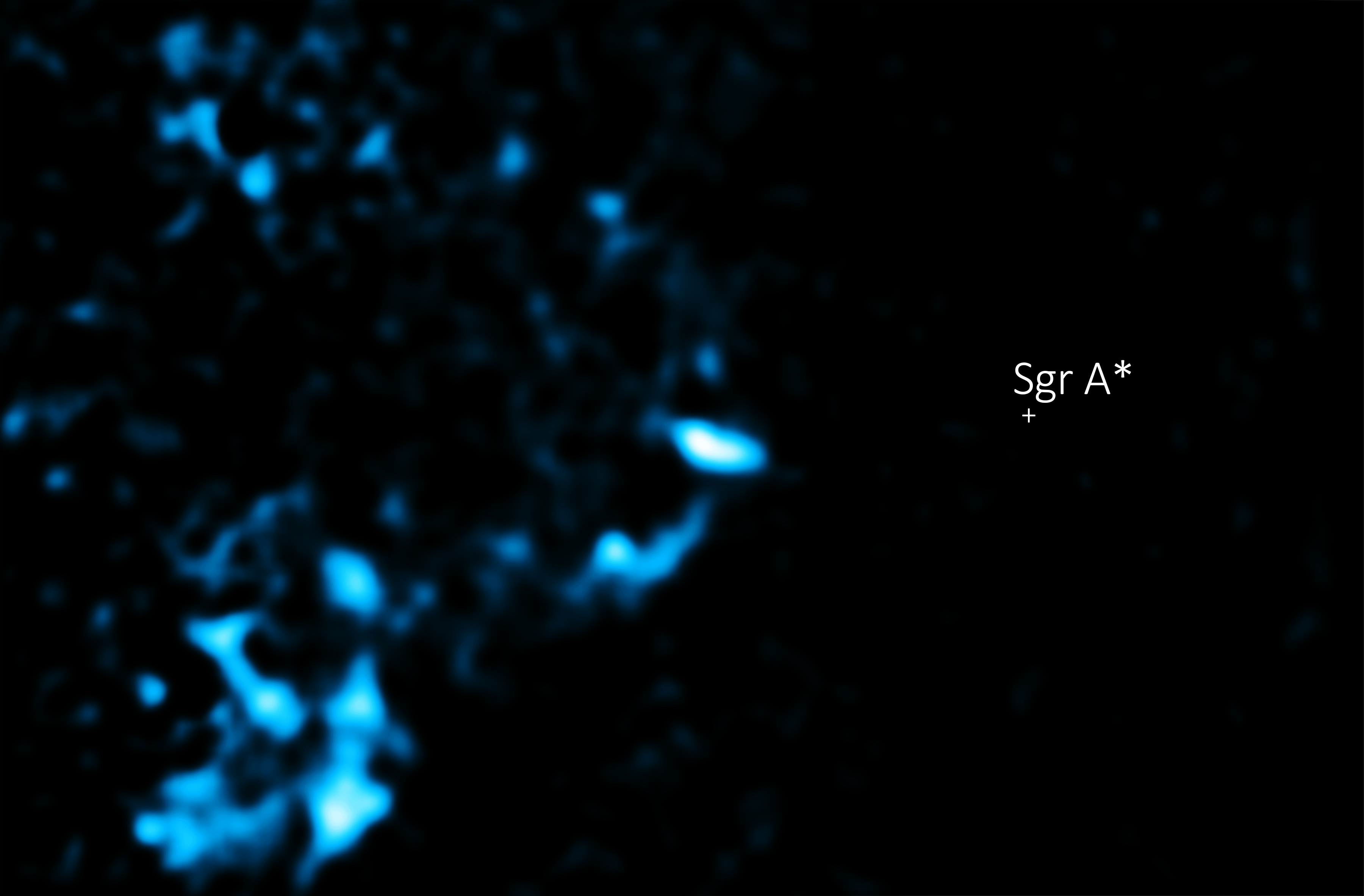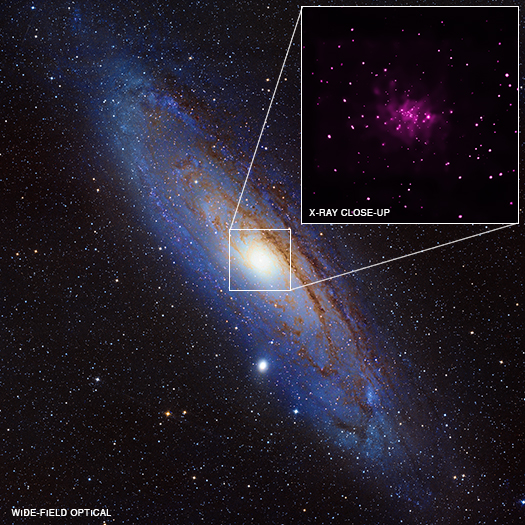Black Holes
A Lighthouse at the Heart of the Milky Way: Hunting Cosmic Neutrinos

Andrea Peterson
We are pleased to welcome Andrea Peterson as a guest blogger today. Andrea is a co-author of a paper reporting that the supermassive black hole at the center of our galaxy may be a source of highly energetic neutrinos, as explained in our latest press release. Andrea recently completed her Ph.D. at the University of Wisconsin-Madison, where she studied particle phenomenology. She is now a postdoctoral researcher at Carleton University in Ottawa, Ontario. She was born and raised in Minnesota, and received her undergraduate degree from Harvard University. She hopes to live somewhere warm someday.
Neutrinos are tiny particles that zoom through the universe at nearly the speed of light. They interact very rarely, so most of the time they pass right through you, me, or any object they encounter. Their ghost-like nature can be a boon for astronomers: they travel from their sources without getting absorbed or deflected. We can use neutrinos to get a clear picture of the very distant universe.
You may have noticed a problem, though. If they don’t interact very often, how can we catch them here on Earth? They have to interact with our detector to be seen!
The solution is size. The bigger the detector, the more stuff there is for the neutrinos to bump into, increasing the chances of detection. The IceCube Neutrino Observatory, located at the South Pole, uses a cubic kilometer of ice to trap neutrinos. In three years, this giant detector has collected 36 extremely energetic neutrinos that are likely to have come from astrophysical sources.
NASA X-ray Telescopes Find Black Hole May Be a Neutrino Factory
The supermassive black hole at the center of the Milky Way, seen in this image from NASA's Chandra X-ray Observatory, may be producing mysterious particles called neutrinos, as described in our latest press release. Neutrinos are tiny particles that have virtually no mass and carry no electric charge. Unlike light or charged particles, neutrinos can emerge from deep within their sources and travel across the Universe without being absorbed by intervening matter or, in the case of charged particles, deflected by magnetic fields.
Suspected Black Hole Unmasked as Ultraluminous Pulsar
An Ultraluminous X-ray Source (ULX) that astronomers had thought was a black hole is really the brightest pulsar ever recorded. ULXs are objects that produce more X-rays than most "normal" X-ray binary systems, in which a star is orbiting a neutron star or a stellar-mass black hole. Black holes in these X-ray binary systems generally weigh about five to thirty times the mass of the sun.
Chandra & XMM-Newton Provide Direct Measurement of Distant Black Hole's Spin
Multiple images of a distant quasar are visible in this combined view from NASA's Chandra X-ray Observatory and the Hubble Space Telescope. The Chandra data, along with data from ESA's XMM-Newton, were used to directly measure the spin of the supermassive black hole powering this quasar. This is the most distant black hole where such a measurement has been made, as reported in our press release.
Blog Posts on a Black Hole Ripping Apart a Star
We are delighted to welcome guest blog posts from Peter Maksym from the University of Alabama and Davide Donato from NASA’s Goddard Space Flight Center (GSFC). These posts give more information about our new press release concerning evidence for a black hole ripping a star apart in a dwarf galaxy. Peter and Davide led two independent studies of this exciting find. We begin with Peter’s blog post.
The Search for a Jet from Sgr A*

We are delighted to welcome a guest blog post from Zhiyuan Li, who led the work explained in our latest press release describing the best evidence yet for a jet from the supermassive black hole in our galaxy. Zhiyuan obtained his PhD at UMass/Amherst and did a postdoc at the Smithsonian Astrophysical Observatory. He went on to a Assistant Reseacher position at UCLA, where he worked with Prof. Mark Morris on the Sgr A* jet. He is currently a Professor of Astronomy at Nanjing University in China.
Today most astronomers believe that a supermassive black hole (SMBH), which weighs several million times more than the Sun, lurks at the very center of our Milky Way galaxy. The existence of such an entity was more just a speculation some 40 years back, when the two British astrophysicists, Donald Lynden-Bell and Martin Rees, first proposed the idea. Lynden-Bell and Rees suggested one particular observational test: "Very long baseline interferometry may soon be possible…to determine the size of any central black hole that there may be in our Galaxy" -- and they were right. There soon came the memorable discovery by Bruce Balick and Robert Brown, who in early 1974 used the Green Bank interferometer to find a compact radio source at the expected position. The source is now widely known as Sagittarius A* (Sgr A*) and accepted as the radio counterpart of the putative SMBH. (Most astronomers would use Sgr A* to denote the SMBH, and we do so below.)
New Evidence For A Jet From Milky Way’s Black Hole
New evidence has been uncovered for the presence of a jet of high-energy particles blasting out of the Milky Way's supermassive black hole. As outlined in the press release, astronomers have made the best case yet that such a jet exists by combining X-ray data from NASA's Chandra X-ray Observatory with radio emission from the NSF's Very Large Array (VLA).
A Glimpse of the Violent Past of Milky Way's Giant Black Hole
Researchers using NASA's Chandra X-ray Observatory have found evidence that the normally dim region very close to the supermassive black hole at the center of the Milky Way Galaxy flared up with at least two luminous outbursts in the past few hundred years.
This discovery comes from a new study of rapid variations in the X-ray emission from gas clouds surrounding the supermassive black hole, a.k.a. Sagittarius A*, or Sgr A* for short. The scientists show that the most probable interpretation of these variations is that they are caused by light echoes.
Too Hot to Swallow

We are delighted to welcome Q. Daniel Wang as a guest blogger today. Daniel is the first author of a paper dissecting the X-ray-emitting gas around the center of our Galaxy, the subject of our latest press release. He is a professor in astronomy at University of Massachusetts Amherst. He was the Principal Investigator of the first large-scale Chandra and Hubble surveys of the Galactic center to explore various components of this exotic ecosystem. He recently enjoyed a four-month stay at University of Cambridge as a Beverley Sackler Distinguished Visiting astronomer, where much of the work reported in the paper was finished.
It has been known for a while that almost all massive galaxies contain a giant black hole at their centers. Most of such black holes, including the one at the center of our own Galaxy, are, however, far dimmer than quasars typically seen in the early universe. This dimness cannot simply be explained by decreasing amounts of material that the black holes could capture. Have the black holes lost their appetite? Or do they just swallow everything that is captured without much radiation? Many theories have been developed. But direct observational tests are hard to come by.






